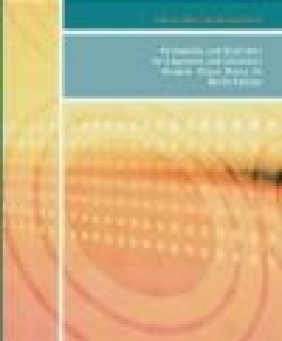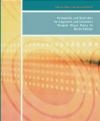Probability and Statistics for Engineers and Scientists
Keying Ye, Sharon Myers, Raymond Myers
Probability and Statistics for Engineers and Scientists
Keying Ye, Sharon Myers, Raymond Myers
- Producent: Pearson
- Rok produkcji: 2013
- ISBN: 9781292023922
- Ilość stron: 864
- Oprawa: Miękka
Niedostępna
Opis: Probability and Statistics for Engineers and Scientists - Keying Ye, Sharon Myers, Raymond Myers
For junior/senior undergraduates taking probability and statistics as applied to engineering, science, or computer science. This classic text provides a rigorous introduction to basic probability theory and statistical inference, with a unique balance between theory and methodology. Interesting, relevant applications use real data from actual studies, showing how the concepts and methods can be used to solve problems in the field. This revision focuses on improved clarity and deeper understanding. This latest edition is also available in as an enhanced Pearson eText. This exciting new version features an embedded version of StatCrunch, allowing students to analyze data sets while reading the book.Preface 1. Introduction to Statistics and Data Analysis 1.1 Overview: Statistical Inference, Samples, Populations, and the Role of Probability 1.2 Sampling Procedures; Collection of Data 1.3 Measures of Location: The Sample Mean and Median Exercises 1.4 Measures of Variability Exercises 1.5 Discrete and Continuous Data 1.6 Statistical Modeling, Scientific Inspection, and Graphical Methods 19 1.7 General Types of Statistical Studies: Designed Experiment, Observational Study, and Retrospective Study Exercises 2. Probability 2.1 Sample Space 2.2 Events Exercises 2.3 Counting Sample Points Exercises 2.4 Probability of an Event 2.5 Additive Rules Exercises 2.6 Conditional Probability, Independence and Product Rules Exercises 2.7 Bayes' Rule Exercises Review Exercises 2.8 Potential Misconceptions and Hazards; Relationship to Material in Other Chapters 3. Random Variables and Probability Distributions 3.1 Concept of a Random Variable 3.2 Discrete Probability Distributions 3.3 Continuous Probability Distributions Exercises 3.4 Joint Probability Distributions Exercises Review Exercises 3.5 Potential Misconceptions and Hazards; Relationship to Material in Other Chapters 4. Mathematical Expectation 4.1 Mean of a Random Variable Exercises 4.2 Variance and Covariance of Random Variables Exercises 4.3 Means and Variances of Linear Combinations of Random Variables 127 4.4 Chebyshev's Theorem Exercises Review Exercises 4.5 Potential Misconceptions and Hazards; Relationship to Material in Other Chapters 5. Some Discrete Probability Distributions 5.1 Introduction and Motivation 5.2 Binomial and Multinomial Distributions Exercises 5.3 Hypergeometric Distribution Exercises 5.4 Negative Binomial and Geometric Distributions 5.5 Poisson Distribution and the Poisson Process Exercises Review Exercises 5.6 Potential Misconceptions and Hazards; Relationship to Material in Other Chapters 6. Some Continuous Probability Distributions 6.1 Continuous Uniform Distribution 6.2 Normal Distribution 6.3 Areas under the Normal Curve 6.4 Applications of the Normal Distribution Exercises 6.5 Normal Approximation to the Binomial Exercises 6.6 Gamma and Exponential Distributions 6.7 Chi-Squared Distribution 6.8 Beta Distribution 6.9 Lognormal Distribution (Optional) 6.10 Weibull Distribution (Optional) Exercises Review Exercises 6.11 Potential Misconceptions and Hazards; Relationship to Material in Other Chapters 7. Functions of Random Variables (Optional) 7.1 Introduction 7.2 Transformations of Variables 7.3 Moments and Moment-Generating Functions Exercises 8. Sampling Distributions and More Graphical Tools 8.1 Random Sampling and Sampling Distributions 8.2 Some Important Statistics Exercises 8.3 Sampling Distributions 8.4 Sampling Distribution of Means and the Central Limit Theorem Exercises 8.5 Sampling Distribution of S2 8.6 t-Distribution 8.7 F-Distribution 8.8 Quantile and Probability Plots Exercises Review Exercises 8.9 Potential Misconceptions and Hazards; Relationship to Material in Other Chapters 9. One- and Two-Sample Estimation Problems 9.1 Introduction 9.2 Statistical Inference 9.3 Classical Methods of Estimation 9.4 Single Sample: Estimating the Mean 9.5 Standard Error of a Point Estimate 9.6 Prediction Intervals 9.7 Tolerance Limits Exercises 9.8 Two Samples: Estimating the Difference Between Two Means 9.9 Paired Observations Exercises 9.10 Single Sample: Estimating a Proportion 9.11 Two Samples: Estimating the Difference between Two Proportions Exercises 9.12 Single Sample: Estimating the Variance 9.13 Two Samples: Estimating the Ratio of Two Variances Exercises 9.14 Maximum Likelihood Estimation (Optional) Exercises Review Exercises 9.15 Potential Misconceptions and Hazards; Relationship to Material in Other Chapters 10. One- and Two-Sample Tests of Hypotheses 10.1 Statistical Hypotheses: General Concepts 10.2 Testing a Statistical Hypothesis 10.3 The Use of P-Values for Decision Making in Testing Hypotheses Exercises 10.4 Single Sample: Tests Concerning a Single Mean 10.5 Two Samples: Tests on Two Means 10.6 Choice of Sample Size for Testing Means 10.7 Graphical Methods for Comparing Means Exercises 10.8 One Sample: Test on a Single Proportion 10.9 Two Samples: Tests on Two Proportions Exercises 10.10 One- and Two-Sample Tests Concerning Variances Exercises 10.11 Goodness-of-Fit Test 10.12 Test for Independence (Categorical Data) 10.13 Test for Homogeneity 10.14 Two-Sample Case Study Exercises Review Exercises 10.15 Potential Misconceptions and Hazards; Relationship to Material in Other Chapters 11. Simple Linear Regression and Correlation 11.1 Introduction to Linear Regression 11.2 The Simple Linear Regression Model 11.3 Least Squares and the Fitted Model Exercises 11.4 Properties of the Least Squares Estimators 11.5 Inferences Concerning the Regression Coefficients 11.6 Prediction Exercises 11.7 Choice of a Regression Model 11.8 Analysis-of-Variance Approach 11.9 Test for Linearity of Regression: Data with Repeated Observations 416 Exercises 11.10 Data Plots and Transformations 11.11 Simple Linear Regression Case Study 11.12 Correlation Exercises Review Exercises 11.13 Potential Misconceptions and Hazards; Relationship to Material in Other Chapters 12. Multiple Linear Regression and Certain Nonlinear Regression Models 12.1 Introduction 12.2 Estimating the Coefficients 12.3 Linear Regression Model Using Matrices Exercises 12.4 Properties of the Least Squares Estimators 12.5 Inferences in Multiple Linear Regression Exercises 12.6 Choice of a Fitted Model through Hypothesis Testing 12.7 Special Case of Orthogonality (Optional) Exercises 12.8 Categorical or Indicator Variables Exercises 12.9 Sequential Methods for Model Selection 12.10 Study of Residuals and Violation of Assumptions 12.11 Cross Validation, Cp, and Other Criteria for Model Selection Exercises 12.12 Special Nonlinear Models for Nonideal Conditions Exercises Review Exercises 12.13 Potential Misconceptions and Hazards; Relationship to Material in Other Chapters 13. One-Factor Experiments: General 13.1 Analysis-of-Variance Technique 13.2 The Strategy of Experimental Design 13.3 One-Way Analysis of Variance: Completely Randomized Design (One-Way ANOVA) 13.4 Tests for the Equality of Several Variances Exercises 13.5 Multiple Comparisons Exercises 13.6 Comparing a Set of Treatments in Blocks 13.7 Randomized Complete Block Designs 13.8 Graphical Methods and Model Checking 13.9 Data Transformations In Analysis of Variance) Exercises 13.10 Random Effects Models 13.11 Case Study Exercises Review Exercises 13.12 Potential Misconceptions and Hazards; Relationship to Material in Other Chapters 14. Factorial Experiments (Two or More Factors) 14.1 Introduction 14.2 Interaction in the Two-Factor Experiment 14.3 Two-Factor Analysis of Variance Exercises 14.4 Three-Factor Experiments Exercises 14.5 Factorial Experiments for Random Effects and Mixed Models Exercises Review Exercises 14.6 Potential Misconceptions and Hazards; Relationship to Material in Other Chapters 15. 2k Factorial Experiments and Fractions 15.1 Introduction 15.2 The 2k Factorial: Calculation of Effects and Analysis of Variance 598 15.3 Nonreplicated 2k Factorial Experiment Exercises 15.4 Factorial Experiments in a Regression Setting 15.5 The Orthogonal Design Exercises 15.6 Fractional Factorial Experiments 15.7 Analysis of Fractional Factorial Experiments Exercises 15.8 Higher Fractions and Screening Designs 15.9 Construction of Resolution III and IV Designs 15.10 Other Two-Level Resolution III Designs; The Plackett-Burman Designs 15.11 Introduction to Response Surface Methodology 15.12 Robust Parameter Design Exercises Review Exercises 15.13 Potential Misconceptions and Hazards; Relationship to Material in Other Chapters 16. Nonparametric Statistics 16.1 Nonparametric Tests 16.2 Signed-Rank Test Exercises 16.3 Wilcoxon Rank-Sum Test 16.4 Kruskal-Wallis Test Exercises 16.5 Runs Test 16.6 Tolerance Limits 16.7 Rank Correlation Coefficient Exercises Review Exercises 17. Statistical Quality Control 17.1 Introduction 17.2 Nature of the Control Limits 17.3 Purposes of the Control Chart 17.4 Control Charts for Variables 17.5 Control Charts for Attributes 17.6 Cusum Control Charts Review Exercises 18 Bayesian Statistics 18.1 Bayesian Concepts 18.2 Bayesian Inferences 18.3 Bayes Estimates Using Decision Theory Framework Exercises Bibliography A. Statistical Tables and Proofs B. Answers to Odd-Numbered Non-Review Exercises Index
Producent:
GPSR Pearson Central Europe Sp. z o.o.
ul. Szamocka 8
01-748 Warszawa (PL)
tel: 459 596 060
email: [email protected]
Szczegóły: Probability and Statistics for Engineers and Scientists - Keying Ye, Sharon Myers, Raymond Myers
Tytuł: Probability and Statistics for Engineers and Scientists
Autor: Keying Ye, Sharon Myers, Raymond Myers
Producent: Pearson
ISBN: 9781292023922
Rok produkcji: 2013
Ilość stron: 864
Oprawa: Miękka
Waga: 1.51 kg





























